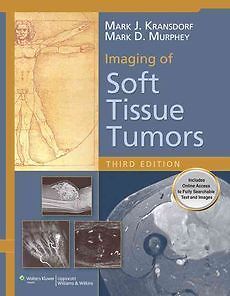Authors: Mark J. Kransdorf and Mark D. Murphey
Publisher: Wolters Kluwer | Lippincott Williams & Wilkins
Book Review by: Nano Khilnani
This text comes with access to the complete contents online, full searchable, plus other valuable features. Scratch off the gray sticker on the inside front cover of your book to get your access code. Three simple steps to gain instant access:
1) Visit http://solution.lww.com
2) Enter your access code
3) Follow the instructions to activate your access
For technical assistance, call 1-800-468-1128 in the United States or 1-410-528-4000 outside the U.S., or email: CustomerService@LWW.com
This book is for radiologists, pathologists, oncologists and others involved with locating soft tissue tumors and tumor –like masses, and evaluating whether they are malignant or benign.
The authors,- specialists in radiology, musculoskeletal imaging and radiologic pathology – present hundreds of images in this book and offer their knowledge and that of others on them.
They present the results of a retrospective analysis of 31,047 soft tissue tumors that were seen in the course of consultations with patients over a decade, beginning on January 1,1980, at the Department of Soft Tissue Pathology at the Armed Forces Institute of Pathology in Washington, DC.
The tabulation of results from this large population of over 31,000 people is presented at the beginning of the book after the Introduction. The wealth of data provided on about 20 pages shows you:
• Types of malignant soft tissue tumors (121 major diagnostic categories); numbers of people who had each type, with 2,978 (largest number) of them having malignant fibrous histiocytoma and just 8 having malignant paraganglioma This is based on an analysis of 12,370 total cases seen in consultation over a 10-year period (Table 2.1).
• Types of benign soft tissue tumor; numbers of people who had each type, with 2,999 (largest number) having lipoma and lipoma variants, and just 37 having ganglioneuroma. This is based on an analysis of 18,677 cases seen in consultation over the course of a decade (Table 2.2).
A summary of the age and sex of patients as well as the distribution of lesions for all histological diagnoses is shown in Table 2.3 to 2.14
This book of 768 pages provides extensive coverage of soft tissue tumors and discussions of each type. Here is an overview of the subject matter, simply organized in 14 chapters:
• Origin and Classification of Soft Tissue Tumors
• Soft Tissue Tumors in a Large Referral Population: Prevalence and Distribution of Lesions by Age, Sex and Location (on the Body)
• Imaging of Soft Tissue Masses
• Lipomatous Tumors
• Vascular and Lymphatic Tumors
• Fibrous and Fibrohistiocytic Tumors
• Muscle Tumors
• Neurogenic Lesions
• Synovial Tumors
• Extraskeletal Osseous and Cartilaginous Lesions
• Lesions of Uncertain Differentiation
• Superficial Soft Tissue Masses
• Masses That May Mimic Soft Tissue Tumors
• Compartmental Anatomy and Biopsy Planning
The organization of material in chapter s is excellent. Each chapter begins with a box that lists major topics. After an Introduction, each topic is discussed. A box entitled Key Concepts precedes discussion of each topic.
Large numbers of images with detailed captions are presented to help understand and see what a particular tumor or mass of tissue looks like. Most of the images are black-and-white radiographs, but occasionally full-color photos are shown. Tables providing information at a glance also abound in the pages.
Lists of books and other materials for further study are presented in the References section at the end of each chapter
This is a highly valuable book and unique on its focus on soft tissue tumors. Books on soft tissue tumors are possibly rare in medical book publishing, but this was made possible with the efforts of its two authors named below:
Mark J, Cransdorf, MD is a Consultant in the Department of Radiology at the Mayo Clinic in Phoenix, Arizona.
Mark D. Murphey, MD is Chief of Musculoskeletal Imaging at the American Institute for Radiologic Pathology in Silver Spring, MD. He is also affiliated with the Uniformed Services University of the Health Sciences in Bethesda, MD, and with the Department of Radiology at the National Military Medical Center in Bethesda, MD.








